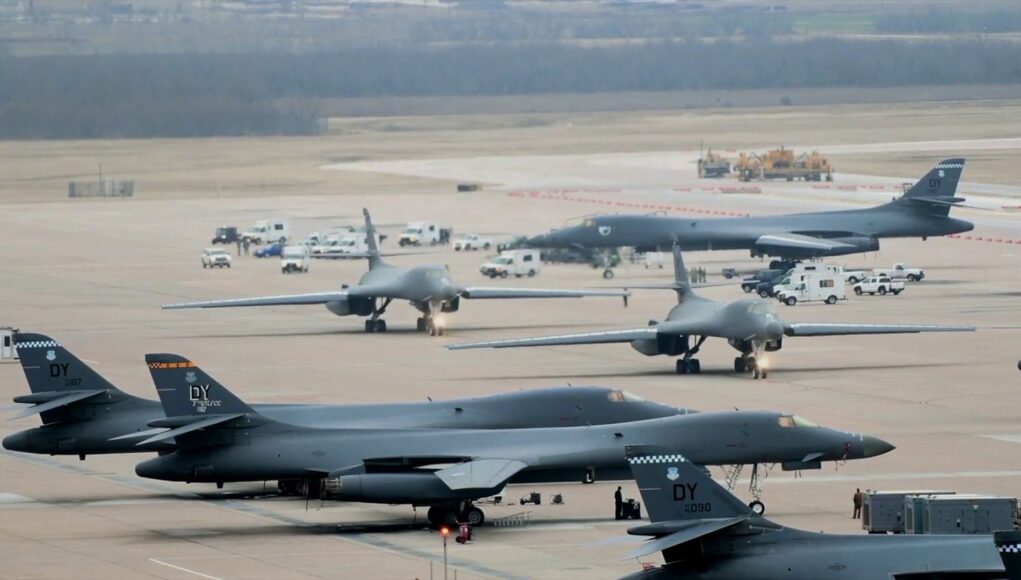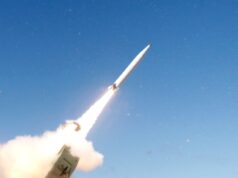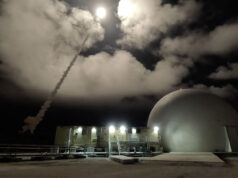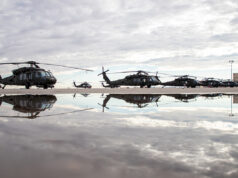In support of efforts to modernise America’s bomber fleet, the U.S. Air Force have announced that it will begin retiring 17 B-1B Lancers from its current fleet.
“This action will not affect the service’s lethality or any associated maintenance manpower. It will allow officials to focus maintenance and depot-level manpower on the remaining aircraft, increasing readiness and paving the way for the bomber fleet modernization ready to meet future challenges”, the U.S. Air Force said in a statement.
“Beginning to retire legacy bombers, to make way for the B-21 Raider, is something we have been working toward for some time,” said Gen. Timothy Ray, commander of Air Force Global Strike Command.
“Due to the wear and tear placed on the B-1 fleet over the past two decades, maintaining these bombers would cost tens of millions of dollars per aircraft to get back to status quo. And that’s just to fix the problems we know about. We’re just accelerating planned retirements.”
The 17 B-1B aircraft will be retired from the current fleet of 62 B-1s, leaving 45 in the active fleet. Of the 17 B-1 aircraft, four will be required to remain in a reclaimable condition that is consistent with Type 2000 recallable storage.
“Retiring aircraft with the least amount of usable life allows us to prioritize the health of the fleet and crew training”, Ray added. “Our ability to balance these priorities will make us more capable and lethal overall.”
With fewer aircraft in the B-1 fleet, maintainers will be able to give more time and attention to each aircraft.
“The divestiture of the B-1 is necessary in order for the Air Force to create an even more lethal, agile and sustainable force with a greater competitive edge for tomorrow’s fight,” Ray said.










Such an elegant and yet somehow sinister looking thing. I do wonder whether history will look back upon manned aircraft, especially ones designed to actually take large tonnage of heavy explosives to another location such as these, as being anachronistic in the extreme.
In the same way we have realised that individual armour for our soldiers is essential, yet had written that off as being obsolete after the medieval period?
Things go in circles, but a big thing carrying lots of little things nearer to their destination being more efficient than the little things all going all the way direct – is unlikely to lose its fundamental appeal.
Just as we still want frigates doing the same things frigates did centuries ago, despite the inventions of aircraft and submarines that cover the ground faster and with more capability.
The whole armour thing going out of fashion is not actually true. It was more that the effectiveness of available armour vs cost and effectiveness made it a poor investment for for general use in large field armies.
surprisingly metal Armor covering the torso was still in wide use by many Cavalry forces in the opening stages of world war 1 as these were smaller forces, where the weight of armour and cost were less of an issue, they were also expected to close and need protection against edged and pointed weapons. Just at the point everyone realised metal torso armour was as pointless as men on horses the number of casualties being created by air bust shells meant it was worth investing in cheap metal head armour as this worked against these weapons. There were also sets of heavy metal armour created for individuals who were likely to be static like spotters and machine gunners ( the Germans created 400,000 of these suites of what were effectively full metal armour suites) but they were not an option for normal troops ( cost and weight and did not really do much).
post world war 2 there were lots of studies on casualty reduction as reducing casualties over cost became a major driver. We also have developed better material science so it’s not a matter of steel or nothing……The problem always faced was that casualties occurred by different causes and studies showed most were from shrapnel, now the problem is that armour to protect against shrapnel ( a high velocity steel object that personal armour can’t deform as a way to reduce energy) needed to be different to armour that defeated bullets which are best managed by deforming them to reduce their energy by the theory of work. The problem is that the best way to cause massive damage is by deforming or tumbling a bullet, so you must stop the bullet or let it go unhindered and hope they are not using a round with a designed deforming or tumbling bullet….. You could make the perfect bullet resistant armour but the poor soldier would be dropping dead from exertion or not able to find cover.
The B-21 passed its Critical Design Review in December 2020 which means that the design is now frozen and the cost determined – $550 million in 2010 dollars – about $650 million. Two aircraft are in production. The first test flight is expected in the next six months but, given the classification of the program, it’s unlikely the Air Force will provide any detailed information.
First test flight? It may have flown already from Groom. If not full size a smaller version.
No. There is absolutely no reliable information that a demonstration aircraft or a smaller version has been produced at Palmdale and sent to Groom Lake, as the USAF calls it. It makes no economic sense to produce it. Nor an engineering one. That was not done with the B-2 and the USAF has followed the same practice here. The USAF Program Director himself has spoken about the first flight which he had hoped would occur in December of 2020 but didn’t. Most likely COVID related.
You have no idea what happens at Groom, or around it.
I would be my life that something, or rather some things, related to the B21 have been flying from Groom et all for over a decade. Hence why the program has gone seemingly so smoothly. That is after all, the idea…
Nonsense. I actually have ben at Groom Lake TDY on several occasions while on active duty and I know one hell of a lot more about it than you do. Bet your life all you want, you’ll just lose it. You just don’ know what you are talking about. he very fact that you refer to it as “Groom” indicates you don’t.
Bullshit.
If you had actually been anywhere in that area you would not be bragging of it on an internet forum.
Your total lack of insight is further evidence.
See my reply to Daniele Mandelli. The bullshitter here is you. You are ignorant of the facts and have absolutely no idea what you are talking about.
What facts? Your posts are a fact free vacumn!
NTTR absolutely does have platforms in support of B21. Only a eejit would try and deny that. It’s not a major secret, nor is it unexpected – the secret bit is what they are exactly, what they can do and what is done with them.
I bet the closest you’ve ever been to that area was watching a film set in Vegas.
I’d ask you what colour the boat house is at Groom but I don’t think a teenager would have seen that film.
“Groom” is the same as us saying “Lossi” for Lossimouth PK, so that is a poor comparison.
If you have served there, who can say, and if so then of course you can comment on the location, though not on programmes as you should know full well things are compartmentalised.
I think anyone who studies the subject that much as some here know what the names for Groom Lake are, and there are several apart from its official designation.
Rogbob has suggested what I was thinking, as in other “black programmes” it was suggested subscale demonstrators may have flown, much like the Have Blue and others over the decades.
That was all I was suggesting.
Your first comment “There is absolutely no reliable information that a demonstration aircraft or a smaller version has been produced at Palmdale and sent to Groom Lake”
Agreed. There IS no reliable information. And there won’t be. Which is why I said “may” rather than “has”
The US Air Force, a number of years ago, acknowledged the existence of Groom Lake AFB and has listed it as one of its bases for a number of years. Airman assigned there acknowledge that they are assigned there. The work may be classified but the base and location are no longer. Your knowledge is based on uniformed alien spotting bloggers; mine is from first hand knowledge. And I don’t give a damn if you believe me or not.
It would be cost prohibitive to build a demonstrator. One was not built for the B-2 and there is no need to do so for the B-21 since it, based on the artist drawing officially released by the USAF, is a next generation B-2.Building a Have Blue prototype is nowhere near as involved or expensive as building a bomber demonstrator.
I’ll stick to the real world. You can stick to alien seeking fantasy bloggers who know absolutely nothing.
Deary me.
The UK should seriously consider a squadron of B-21s.
Paid for by cutting what?
@ £500m each we can’t afford them if we are struggling to buy enough F35B’s which are only £80m each…..
Why?
For the price of a single B-21 bomber we could have half a dozen F35s or Typhoons.
A dozen B-21s would cost £6.6billion; the equivalent of…
– Over 80 x F35s or Typhoons, or 50 of either plus a half dozen extra, each of P8 Poseidons and E7 Wedgetails.
– 4 x Astute class submarines
– 5 x Type 26 frigrates plus change.
– 20 x Type 31 frigates
– enough to completely replace Challenger 2 at least on a one for one basis.
I’d much rather any one of those to a squadron of shiny bombers without much use.
You need to think lifecycle costs. Upfront purchase is relatively small beer vs in service costs.
Where the nunber of people and infra required starts to be significantly different, then the in service costs will be logarithmically higher.
So a dozen B21s, or more accurately say 8-9 (equiv to C17/P8 fleets) is going to be more like a 20-30 strong Typhoon force, 1 SSN or 2 frigates. At that point the long range and endurance, plus high capacity of the B21 suddenly look very different.
I wouldnt look at it as a penetrating strategic ac – its the range/endurance and capacity plus reloadability vs tactical and naval platforms.
2 crew, twin engined and post F35 surface treatments expertise, will transform its running costs vs legacy bombers to something reasonsble.
I’d scrap the entire Tranche 1 Typhoons (40 jets, largrly useless anyway) to have 6-8 of these without any hesitation.
Except those 30-odd Typhoons are much more versatile than a large heavy bomber.
Those 8 or 9 bombers cannot intercept enemy aircraft, nor can they provide close air support to our ground forces. Their only job is long range heavy bombing missions. I can’t think of a single likely scenario where those bombers can do it better than what we already have.
The fact that people need to face is this: our defence budget is limited. We cannot afford to spend half a billion pounds on a bomber that is for a single purpose and can be done by existing multirole assets. Only the US and China can afford that; the only reason Russia can really afford them is that they’re really, really old.
Even if our defence budget increased to 3% of GDP (£60 billion a year) we can’t afford to spend money on frivolous things like that.
Those 30 Typhoons are borderline useless actually.
Not even useful for training increasingly given the differences between them and Tranche 2/3 war goers. Even of limited use for QRA given Meteor.
And all at a pain in the arse maintenance burden (vs newer) that is only going to get worse.
It’s why the RAF wasn’t unhappy to be rid of them, and post this IR may well be!
Binning them for something that can provide persistent capacity at range would be a massive gain for the force. Describing it as one trick or frivolous exposes your own ignorance. We also have enough Typhoons anyway, indeed so many thet finding places to store them was the concern!
Again you miss the point by mentioning the procurement cost. That half billion is peanuts vs the lifetime costs, of which 9 bombers will be less than 30 jets.
Enthusiasts always talk about purchase “sticker price” costs and start comparing them such as X of this or Y of that.
Professionals barely talk about this. All professional discussion is about: infra change costs, integration costs with other systems, ongoing need for development (dedicated units, upgrades of older variants etc), parts/repair and consumable costs and generating/sustaining trained people costs. All of those dwarf the sticker price. It’s that total cost you need to consider, except as an enthusiast you cant because you have little idea what the other components are. That isnt a criticism, even large numbers of professionals trying to work this out struggle.
Remember, the services are as, if not more, constrained by people costs (numbers) than sticker price costs. Frequently it is better to pay more up front cost than it is take on an increased people commitment as that comes with lags and uncertainties and of course there is a large recruitment/training cost (and you cant magic experienced or more senior people quickly). Hence why so much is contracted, although that comes with its own issues…
I dont think bombers is a realistic prospect, but the trade offs mentioned are grossly out and I’d bet my house that they’d be on the agenda with only a small increase in resources – certainly before more of what we already have (and especially where that is already more than we need).
I wasn’t talking about our old Tranche 1 Typhoons, I was referring to Typhoons generally. As in: if we had a £6billion+ pot of money to spend on aircraft I’d rather it go on more Typhoons, or F35b than a squadron of heavy bombers. Scrapping the old Tranche 1s wouldn’t make any difference in being able to afford heavy bombers.
You mention my ignorance at my calling such heavy bombers one trick ponies, but what else can they do?! Useless in air to air combat, can’t do close air support, too much of a prized asset for a recce sortie.
You’re using a half-billion pound aircraft, which requires a 3rd stream of spare parts, training etc, to drop 20-30 bombs or launch that many cruise missiles when 99 times out of 100 a single, or pair of Typhoons could do the same job with a Paveway or Storm Shadow. And said Typhoons or F35 can do all the above duties I mentioned.
So yes, it is frivolous. For anyone without the US or China’s defence budget. One big hint of that is the fact that outside of those 2 and Russia, literally no one else has heavy bombers.
Actually it was me talking about old Typhoons because, and making this point is becoming weariesome – they exist, and they cost us a fortune in all those life cycle costs I wrote about, whilst you still obsess on sticker price.
Your 6B is a misnomer. It is the 30+ years of operating and support costs that matter. And your sqaudrons of Typhoons and F35s will cost far more in that sense than a nominally equivalent procurement cost of B21s.
If we only need a pair of Typhoons, given we have c100 Tr2/3, why would we need more?
The RAF wanted F35As because they offered a LO equivalent of Typhoon, and a more useful range akin to Tornado, which itself was still less than what was wanted.
If you want to know what the RAF actually wants to do its job, should it have additional funds, look at what FOAS was to be. Even that was a fudge of what they thought might fly politically. Typhoons/F35Bs are a poor subsitute, a B21 is smack what is actually desired in giving range, endurance and capacity.
The fact we dont have bombers is because the entry costs to development were so high and in the timeframes in question, the B1 and B2 were horrifically expensive to buy and even more so to operate, even for the USAF hence reducing numbers/so few built. B21 breaks that to some extent althiugh as before, this isnt a serious proposition in an era of further cuts.
As various types show, we are happy to have aircrsft in service in low numbers that offer strategic or operational impact in the way a bomber does vs a tactical jet.
Fascinating explanation.
It is probably moot anyway, would they even consider selling the aircraft? Even to the UK? I know they offered a version of F117 to the RAF once but that was in Reagans time.
Well yes, the elephant in the room!
Perhaps, they sold us RJ, we are well embedded in F35 and its not in the same secrecy league as B2 was nor does it have the legislative restrictions that accompanied F22. But in truth it is perhaps a bit too much aeroplane given the Pacific like range and a capacity more tied to USAF weapon stores vs our own which we depleted using a couple of dozen Tonka/Typhoons!
AIUI, pre end of the Cold War more was hoped for F117 including developed version(s) and a permament Europe det, for which UK was a good choice for basing and the most secure, hence I think several suggestions over the period. I dont know but perhaps those were seen, alongside F15Es, as F111 successors noting the F15E was envisaged as a more interim platform until the post Cold War reality of budgets and that it was perfect for the requirement emerged, hence lack of F22 parallel.
Thanks for that.
Good Lord no.
No one but the USA can afford them. And we have no need for a penetrating strategic bomber. For nuclear role Trident/Vanguard is more than enough.
Conventional role we have Typhoon and F35 for 1st night penetration or stand off weapons platform. And TLAM.
If we needed to drop a lot of bombs on someone we should buy B-52’s.
Indeed.
Are you serious? $548m a pop?? Get real Billy! We don’t need them. We will be lucky if we ever get 4 active F35 squadrons at ‘only’ $85m per ship. Lets have a fixed wing FAA worth the tag. 4 frontline squadrons and ditto for the RAF. Big bombers? Not for us.
Can the RAF have some second hand B1Bs? Handy to have a few long range carpet bombers. Haven’t had that capability since the Vulcan – which was sent to the South Atlantic.